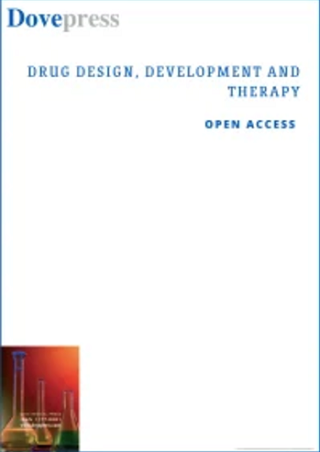Integrating Network Pharmacology and Experimental Validation to Investigate the Mechanism of Qushi Huatan Decoction Against Coronary Heart Disease
IF 4.7
2区 医学
Q1 CHEMISTRY, MEDICINAL
引用次数: 0
Abstract
Purpose: This study was designed to evaluate the effect and mechanism of the Qushi Huatan (QSHT) decoction against coronary heart disease (CHD) through network pharmacology and experimental verification.Methods: In the present study, the active ingredients of the QSHT decoction were identified by ultra performance liquid chromatography/tandem mass spectrometry (UPLC/MS), then the potential ingredients and coronary heart disease targets were predicted using the SwissTarget Prediction database and the database of Genecards and OMIM database, respectively. A herb-compound-target network was constructed using Cytoscape. GO and KEGG enrichment analysis were performed using the ClusterProfiler data package of R software. Molecular docking was used to predict the core targets of QSHT against CHD. In addition, we used a myocardial infarction (MI) and high-fat diet ApoE−/− mice model to investigate the cardioprotective effects of QSHT. Western blotting and immunochemistry were used to verify the core targets and the signaling pathway.
Results: A total of 68 active ingredients were found in the QSHT decoction. Network pharmacology indicated 28 targets and 147 signal pathways, including AKT1, HIF-1α, GSK-3β, TLR4 and NF-κB, those key targets were also verified by molecular docking. The results of GO and KEGG enrichment analysis showed that the targets of QSHT against CHD were largely associated with inflammatory and oxidative stress, and AKT/HIF-1α and TLR4/NF-κB pathways might be key functional pathways. In vivo, QSHT significantly improved cardiac function and attenuated fibrosis and inflammation. Furthermore, QSHT could significantly inhibit the expression of HIF-1α, TLR4, phosphorylation of AKT1, GSK-3β and NF-κB after MI in ApoE−/− mice.
Conclusion: Based on network pharmacology, molecular docking and experimental verification, this study demonstrated that QSHT could improve cardiac function and attenuate cardiac fibrosis by regulating TLR4/NF-κB and AKT/HIF-1α signaling pathway in post- MI and high-fat diet ApoE−/− mice.
Keywords: network pharmacology, molecular docking, Qushi Huatan decoction, coronary heart disease
整合网络药理学与实验验证,探究曲石花丹煎剂防治冠心病的机制
目的:本研究旨在通过网络药理学和实验验证,评价曲石花潭煎膏对冠心病(CHD)的作用和机制:本研究采用超高效液相色谱/串联质谱法(UPLC/MS)对曲氏化潭煎膏的有效成分进行了鉴定,然后分别利用SwissTarget Prediction数据库、Genecards数据库和OMIM数据库预测了曲氏化潭煎膏的潜在成分和冠心病靶点。利用Cytoscape构建了草药-化合物-靶标网络。使用R软件的ClusterProfiler数据包进行了GO和KEGG富集分析。分子对接被用来预测QSHT抗心肌梗死的核心靶点。此外,我们还利用心肌梗死(MI)和高脂饮食载脂蛋白E-/-小鼠模型研究了QSHT的心脏保护作用。我们使用了 Western 印迹和免疫化学方法来验证核心靶点和信号通路:结果:在羌活水煎剂中发现了68种有效成分。网络药理学显示了28个靶点和147条信号通路,包括AKT1、HIF-1α、GSK-3β、TLR4和NF-κB。GO和KEGG富集分析结果表明,QSHT防治冠心病的靶点主要与炎症和氧化应激有关,而AKT/HIF-1α和TLR4/NF-κB通路可能是关键的功能通路。在体内,QSHT 能明显改善心脏功能,减轻纤维化和炎症反应。此外,QSHT还能明显抑制载脂蛋白E-/-小鼠心肌梗死后HIF-1α、TLR4、AKT1磷酸化、GSK-3β和NF-κB的表达:基于网络药理学、分子对接和实验验证,本研究证实瞿氏化瘀汤可通过调节TLR4/NF-κB和AKT/HIF-1α信号通路,改善心肌梗死后和高脂饮食载脂蛋白E-/-小鼠的心功能,减轻心脏纤维化。
本文章由计算机程序翻译,如有差异,请以英文原文为准。
求助全文
约1分钟内获得全文
求助全文
来源期刊

Drug Design, Development and Therapy
CHEMISTRY, MEDICINAL-PHARMACOLOGY & PHARMACY
CiteScore
9.00
自引率
0.00%
发文量
382
审稿时长
>12 weeks
期刊介绍:
Drug Design, Development and Therapy is an international, peer-reviewed, open access journal that spans the spectrum of drug design, discovery and development through to clinical applications.
The journal is characterized by the rapid reporting of high-quality original research, reviews, expert opinions, commentary and clinical studies in all therapeutic areas.
Specific topics covered by the journal include:
Drug target identification and validation
Phenotypic screening and target deconvolution
Biochemical analyses of drug targets and their pathways
New methods or relevant applications in molecular/drug design and computer-aided drug discovery*
Design, synthesis, and biological evaluation of novel biologically active compounds (including diagnostics or chemical probes)
Structural or molecular biological studies elucidating molecular recognition processes
Fragment-based drug discovery
Pharmaceutical/red biotechnology
Isolation, structural characterization, (bio)synthesis, bioengineering and pharmacological evaluation of natural products**
Distribution, pharmacokinetics and metabolic transformations of drugs or biologically active compounds in drug development
Drug delivery and formulation (design and characterization of dosage forms, release mechanisms and in vivo testing)
Preclinical development studies
Translational animal models
Mechanisms of action and signalling pathways
Toxicology
Gene therapy, cell therapy and immunotherapy
Personalized medicine and pharmacogenomics
Clinical drug evaluation
Patient safety and sustained use of medicines.
 求助内容:
求助内容: 应助结果提醒方式:
应助结果提醒方式:


